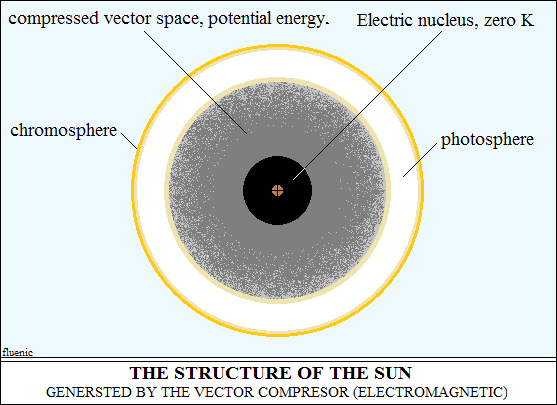The Sun, vector compressor.
The Sun is a macroscopic vector structure, formed by asymmetric vector
circuits, i.e. one circuit (electric) is completely surrounded by the
other
circuit (magnetic). The orthogonal circuits being the vector polarities
of the
hydrogen vector structures, the structure is macroscopic. The centripetal
forces of the vector (electromagnetic) circuits compress centripetally
and exponentially the vector space and the content of the solar system.
The interactions of vector properties thus constitute a vector compressor
(electromagnetic). As a function of increasing pressure and density towards
the center of the solar sphere, the reactions of hydrogen gas compose
distinct concentric layers: In the layer called the chromosphere, pressure
excites fusion reactions, hydrogen forming light elements, helium.
In the layer called the photosphere, pressure stimulates the decomposition
and composition of hydrogen structures and an abundance of vector
oscillations. The photosphere layer emits the kinetic energy of radiation
radially, in the form of oscillations and vector structures of hydrogen.
Hydrogen, generated and released into the solar atmosphere by the activity
of the photosphere, reproduced orthogonally closed vector circuits,
reduced-scale stellar compressors, called planets, thus forming the solar
system. The photosphere also emits oscillations centripetal, with the
inner
face of the layer. The thickness of the photospheric layer is limited
by
pressure, by the density of orthogonal circuits. If up to the photosphere
the
pressure of the vector space also included the structures of hydrogen
gas,
beyond the photosphere, towards the center, the pressure becomes
exclusively vector space, oriented in orthogonally closed vector circuits.
Therefore, the kinetic energy of the oscillations emitted by the photosphere
becomes potential energy, as the pressure increases. In other words, the
photosphere is the limit towards the center of the solar sphere, of the
kinetic
state of energy. This state of energy is evident in the center
of galactic systems, called dark matter and black holes.
The terrestrial stellar compressor.
The photosphere of the terrestrial stellar compressor managed to reproduce
a macroscopic vectorial structure - the moon. The reduced pressure,
conducive to fusion reactions in the chromosphere, generated
the elements of the periodic table, to the detriment of the photosphere,
which became lava. This evolution characteristic of the planets,
formed the solid crust and the biosphere of the earth.

